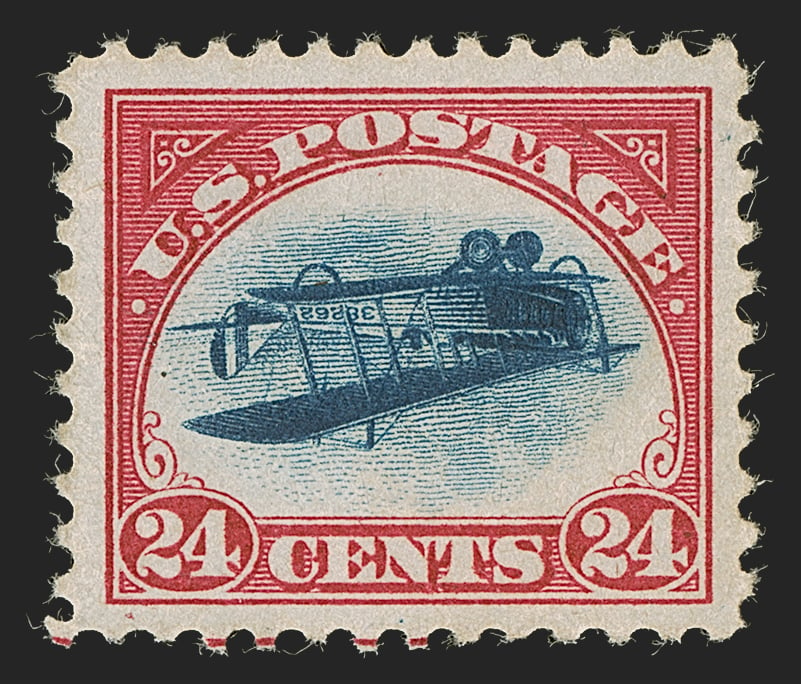
The infamous Inverted Jenny, one of the most collectible stamps in the world, has set a new auction record for a U.S. stamp, with a $2 million sale at New York’s Robert A. Siegel Auction Galleries. That’s an 835.8 million percent increase from its original price of just 24 cents.
“This is not only a record-breaking price for a single Inverted Jenny, but the first time a single United States stamp has ever brought more than $2 million at auction. It is a historic moment for the entire hobby, as well as our auction house,” Scott Trepel, Siegel’s president, wrote in an email.
The stamp was produced in 1918 to commemorate the introduction of the U.S. postal service’s first airmail delivery between New York City, Philadelphia, and Washington, D.C. It became an instant collector’s item when a single sheet was sold with the Curtiss JN-4 or “Jenny” airplane printed upside down.
“In their rush to get the stamps finished on time for the first airmail flight, they created an invert,” Trepel said in a statement. “When they went to print the airplane design on the stamp, they put the plate down the wrong way, and that makes it appear that the airplane is flying upside-down. They destroyed all the error sheets except for one sheet of 100.”
This “Inverted Jenny” plate block sold for $4.9 million at Sotheby’s in 2021. Courtesy of Sotheby’s.
William T. Robey, the lucky bank teller who purchased those 100 stamps on the release day, had gone to the post office hoping he might catch a printing error in only the second two-color stamp ever issued by the U.S. postal service. Though he spent just $24, within the week he sold the whole lot for $15,000 to another collector, Eugene Klein, who flipped it the same day for $20,000. (The two men received a 624,900 percent and 33.33 percent return on their investments, respectively.)
The Inverted Jenny, designed by Clair Aubrey Huston for the U.S. Bureau of Engraving and Printing, has since become prized among philatelists. It is something of a holy grail of the field—and even appeared on a 1993 episode of The Simpsons, where Homer discards a sheet of stamps selling for five cents at a swap meet because “the airplane’s upside down.”
The third owner of the Inverted Jennys, Edward Green, divided the sheet of 100 into one section of eight, seven blocks of four, and 64 individual stamps, each hand-numbered on the back.
In 2021, one of the sets of four fetched $4.9 million, the largest sum ever achieved by a U.S. philatelic item, at a Sotheby’s New York auction that featured several high-profile lots from the collection of shoe designer Stuart Weitzman.
The condition of the remaining stamps varies widely, but the one on offer at Siegel, from position 49, is considered to be the best of the bunch. Klein sold it in 1918 and it remained in the same family for 100 years, stored in a bank vault under ideal conditions. Its whereabouts were unknown for decades, until the family came forward in 2018. The current seller won it at auction at Siegel in 2018, for a then-record $1.59 million.
The Philatelic Foundation and Professional Stamp Experts, two leading stamp grading organizations, both gave this example a score of 95 out of 100 thanks to its bright colors and pristine qualities, noting that the gum condition is the ideal “Mint Never-Hinged”. This means that the stamp is not only unused, but was never mounted in a stamp album using a stamp hinge or mount.
“That is the highest grade an Inverted Jenny has ever, or will ever, receive. We have tracked each of the stamps and are certain no other example compares to this one,” Trepel said. “For the collector, it simply doesn’t get better than this.”
The world record for all stamps stands at $9.5 million, set by the 2014 sale of a rare One-Cent Magenta, printed in the U.K. and known as “the Mona Lisa of stamps.” It sold again for $8.3 million in the 2021 Weitzman sale, to London stamp dealer Stanley Gibbons.
At Siegel, a bidding war broke out among three potential buyers, with Inverted Jenny hammering down at $1.7 million on an estimate of $1.5 million to $2 million. The winning bidder has chosen to stay anonymous.
More Trending Stories:
Revealed: The Major Mystery Consignors of New York’s Multi-Billion-Dollar Fall Auction Season
Christie’s Pulled Two Works by a Prominent Middle Eastern Artist From Sale After a Complaint